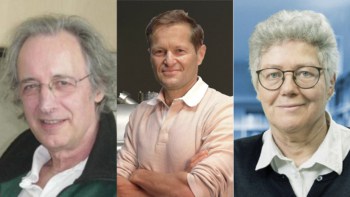When gas bubbles trapped in a liquid are excited by sound waves, they emit short pulses of light - a phenomenon known as sonoluminescence. Physicists have tried to establish the molecular or atomic origins of this light by analysing its components, but they have found only broad featureless spectra. Now Kenneth Suslick and coworkers from the University of Illinois at Urbana-Champaign have seen the fingerprints of individual molecules in single-bubble sonoluminescence spectra for the first time (Y T Didenko et al 2000 Nature 407 877).
Although researchers have proposed a wide variety of explanations for sonoluminescence, they are in broad agreement that the oscillating bubbles reach very high temperatures. Until now, however, single-bubble sonoluminescence has been observed only from air bubbles trapped in water, although very weak emissions have been detected in some alcohols. Suslick and colleagues predicted the necessary characteristics for a liquid to support sonoluminescence, and successfully produced the effect in a wide range of organic liquids. “Our discovery has dramatically increased the range of parameters over which sonoluminescence can be studied,” Suslick told PhysicsWeb. “Our results give direct proof of the existence of chemical reactions and the formation of molecular excited states during sonoluminescence”.
Suslick’s team analysed the sonoluminescence spectra from organic liquids including formamide and methylformamide and noticed a peak corresponding to the emission from an excited state of cyanide (CN). CN vapour from the liquid diffuses into the bubble as it expands. The vapour is then rapidly heated as it is compressed inside the contracting bubble, pushing molecules into a higher energy state. The light is emitted when the excited molecules subsequently drop to a lower energy state as expansion begins again. The CN transition observed by Suslick’s team also places an upper limit on the temperature inside the bubble – because it can only take place at temperatures below 15000 kelvin.
Scientists have known for 70 years that clouds of bubbles exhibit sonoluminescence, but it was observed in single bubbles for the first time only ten years ago. The sonoluminescence spectra from clouds of bubbles are dominated by atomic and molecular emissions. “The new observations provide a spectroscopic bridge between single-bubble and bubble-cloud sonoluminescence”, explains Suslick.



